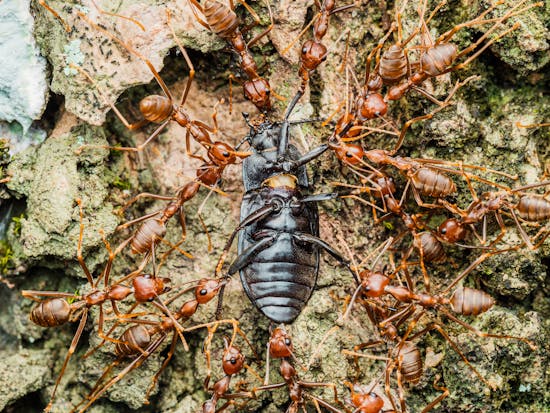
If you’ve ever heard of bull ants, you might be wondering, “Are bull ants dangerous as people say?” Well, as an Australian from Sydney who’s been hiking since my late teens, I’ve had my fair share of encounters with these aggressive ants and a few months back experienced one of their painful stings for the first time!
Luckily, it was through my hiking pants, one reason why I always hike in long pants. I instantly felt the painful sting on my leg, just above the knee and brushed my attacker away. I was in the middle of a steep section of a hike out of a gorge and didn’t have the luxury of attending to it straight away. When I did examine the sting site I found a 1.5 inch or 4 cm round, red welt! The area ached while I finished the walk but I felt fine.
I’ve hiked all over the world, but Australia’s wildlife—including bull ants—holds a special place in my heart for both the beauty and the challenges it offers. So, let’s dive into what makes bull ants both fascinating and potentially dangerous, especially for those considering a hike Down Under.
What Are Bull Ants?
Bull ants (Myrmecia spp.) are one of the largest ant species in Australia, and they live up to their fierce reputation. These ants can grow up to 40 mm in length and are instantly recognizable by their long, lean bodies, large eyes, and powerful mandibles. Their aggressive nature and venom-loaded sting make them a creature you don’t want to mess with on your hikes.
Some species even have bright red or orange markings on their heads or abdomens, adding to their striking appearance. Smaller species, like the jumper ants, are known for their ability to leap toward threats.
Where Do Bull Ants Live?
If you’re planning to hike in Australia, particularly in the southeast regions or Tasmania, you might come across these ants. With around 90 species found across the country, they inhabit a variety of environments—urban areas, forests, woodlands, and heathland. Their nests are usually hidden underground, sometimes extending several meters deep, and have small entrances that make them hard to spot.
They are most common in Australia, though there’s always a chance they could spread to other regions like Europe, Asia or the Americas, though it hasn’t happened yet.
What Do Bull Ants Eat?
Bull ants have a varied diet, feeding on insects, invertebrates, nectar, seeds, fruits, and honeydew produced by other insects. While the adult ants consume nectar and plant-based foods, their larvae are carnivorous, depending on worker ants to bring them insects for nourishment. This makes their colonies self-sufficient and highly efficient in maintaining their complex social structure.

Aggressive Behavior and Why You Should Be Careful
One thing you should know as a hiker is that bull ants are aggressive and territorial. With their excellent vision, they can track and chase perceived threats from up to a meter away. And once they decide you’re a threat, watch out—they don’t hold back. Bull ants will latch onto you with their mandibles and repeatedly sting, injecting venom each time.
Their venom is no joke. While it’s not always deadly, the sting is incredibly painful and can trigger allergic reactions, even anaphylaxis in extreme cases. One species, the Australian Bulldog Ant, is even listed in the Guinness Book of World Records as the deadliest ant in the world, responsible for three human deaths since 1936. They can sting multiple times, unlike bees, and will aggressively defend their nests if they feel threatened.
How Dangerous Are They to Humans?
For most people, a bull ant sting will cause pain, swelling, and possibly some localized allergic reactions. Applying ice packs or using over-the-counter antihistamines can help reduce symptoms. However, if you show signs of a severe allergic reaction, such as difficulty breathing, swelling of the face, or dizziness, seek medical attention immediately.
Interestingly, in Australia, traditional bush remedies—like rubbing the tips of broken ferns on the sting—are sometimes used to alleviate the pain. While these methods can offer temporary relief, modern medicine is your best bet for serious reactions.
The Life of a Bull Ant Colony
Bull ants live in colonies of up to 3,000 individuals, which are strictly organized into workers, queens, and males. Worker ants forage and tend to the larvae, while the queen stays in the nest and can live for up to 15 years. Interestingly, in some species, the queen hunts for her own food, which is rare among ant species.
Fun Facts About Bull Ants
- Night Vision: Bull ant workers have developed night vision, allowing them to forage and defend their nests even after dark.
- Highly Toxic Venom: Bulldog ant venom is among the most toxic in the insect world, adding to their dangerous reputation.
- Not Team Players: Unlike many other ants, bull ants don’t rely as much on teamwork. Their defense-focused nature means they are more individualistic in protecting their colony.
What to Do If You Encounter Bull Ants on a Hike
If you’re hiking in Australia, especially in areas known for bull ants, here are a few tips:
- Stay Aware: Be mindful of where you’re stepping. Their nests are often hidden underground with small entrances.
- Avoid Provoking Them: If you see one or a group of bull ants, avoid getting too close. They will defend their territory aggressively.
- Carry First Aid Supplies: If you’re hiking in an area known for bull ants, bring antihistamines and a basic first aid kit in case of stings.
- Know When to Seek Help: If you or someone you’re hiking with shows signs of an allergic reaction, seek medical attention immediately.
Final Thoughts
So, are bull ants dangerous? Yes, they can be, especially if you’re caught off-guard while hiking in their territory. Their aggressive nature and venomous sting make them a creature to respect. But with some caution and awareness, you can safely hike in Australia without too much worry.
As someone who’s spent years hiking around the world, including plenty of treks in Australia, I can say that the experience is well worth it. Bull ants are just part of the adventure of exploring Australia’s wild landscapes—so don’t let them deter you from enjoying the beauty that the land has to offer!
Happy hiking!
Have you had a Bull ant experience you would like to share? Please feel free to share or ask me your questions.
